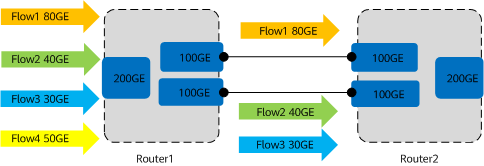FlexE Bonding for Ultra-high Bandwidth Interfaces
The interface rate defined in IEEE 802.3 is fixed and periodic, which cannot meet the requirements of flexible bandwidth-based networking. FlexE bonding can be combined with interface rates to construct links with higher bandwidth.
Traditional LAG Technology for Interface Bonding
As shown in Figure 1, the traditional LAG technology uses the hash algorithm to distribute data flows to physical interfaces. As a result, load imbalance occurs and the bandwidth utilization cannot reach 100%. For example, two 100GE physical interfaces are bonded into a LAG. Assume that there are four groups of data flows. 80 Gbit/s data flows are hashed to the upper link, and 40 Gbit/s and 30 Gbit/s data flows are hashed to the lower link. In this case, the bandwidth utilization cannot reach 100%, regardless of whether 50 Gbit/s data flows are hashed to either the upper or lower link.
FlexE Technology for Interface Bonding
As shown in Figure 2, FlexE can bond multiple physical interfaces to provide ultra-high bandwidth. In addition, FlexE can evenly distribute data flows to all physical interfaces through timeslot-based scheduling, achieving 100% bandwidth utilization and ensuring the 200GE forwarding capability. Customers do not need to wait for new interface standards, and using the existing interface rates is cost-effective.

